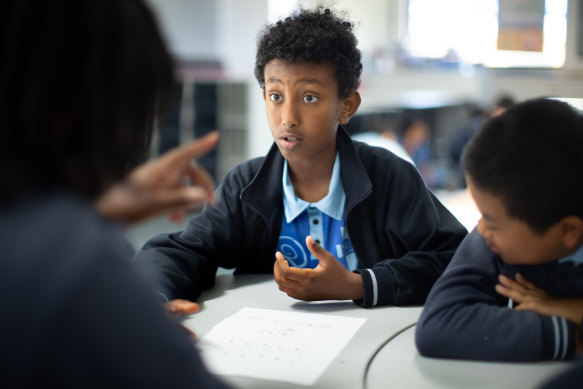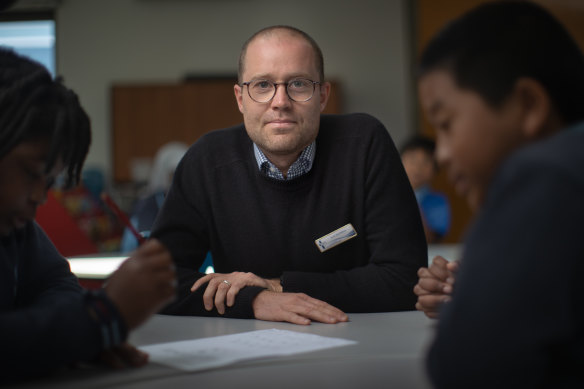By Adam Carey
It’s the last day of classes at St Peter’s Catholic Primary School, and the year 5 and 6 students are sitting in small groups, solving puzzles.
It’s the kind of low-stress play activity that many schools turn to at the tail end of the school year, but in this case, the puzzles have a deeper purpose.

St Peter’s Primary student Filmon Tareke has gained confidence with abstract reasoning over the past two years.Credit: Simon Schluter
The students of this small, diverse school in Sunshine West are participating in a two-year research project to assess if visual puzzles that are solved using abstract reasoning can also unlock latent numeracy and literacy skills.
About 180 year 5 and 6 students from three Catholic schools in Melbourne’s west are participating in the project, which is delivering promising results, lead researcher John Munro says.
In the first year, students had made more than a year’s growth in their abstract reasoning skills, said Munro, the Australian Catholic University’s Professor of Educational Psychology and Exceptional Learning.
Progress in literacy and numeracy was also above average, although this was not yet definitively linked to the project, he said.
Teachers who were looking for ways to realise untapped potential among bright children drove the project, Munro said. They had noticed bright students who started school from behind for a range of reasons, such as having families who did not speak English at home.
“There are a lot of students who have the capacity to achieve at a high level, but who don’t, and they particularly don’t achieve at a high level in either reading comprehension or in numeracy,” he said.
The puzzles, developed by the Australian Centre for Educational Research, test students’ ability to recognise patterns and trends to solve visual and spatial problems.
St Peter’s numeracy leader Jock McMillan said one of the most important aspects of the activity – particularly at a school where 80 per cent of students speak English as an additional language – was how it improved their “ability to articulate their thinking through the puzzles”.
“So we’ve seen our students take questions now in mathematics, and actually be able to stop and use those thinking routines to go, ‘Well, what is it that I’m trying to do? What’s the answer that I’m trying to get to and what skills do I need to get that answer?’” he said.
Year 5 student Filmon Tareke said maths was not his favourite subject, “because I’m not really good at it”, but that he had grown to enjoy the abstract reasoning exercises.
“I used to not be good at it, but I kept doing it and I grew up to enjoy it because you get to talk about it and everyone gets engaged, and it’s really fun to do,” he said.
His year 5 classmate, An-My Dao, said she does enjoy maths, and likes the puzzles best when they are tricky.

Teacher Jock McMillan says one of the most important aspects of the activity is how it improves students’ “ability to articulate their thinking”.Credit: Simon Schluter
“Some of them are hard, it challenges me and I like how it challenges me, it’s visual, and it’s easier to pinpoint than other maths problems.”
For St Peter’s teacher Sharon Campbell, it was more important for students involved in the project to be able to articulate their thinking about how they solved the problem than answer each puzzle correctly.
“We talked about this thing called big brain. That’s their word … what I’m seeing flowing from this is a growth mindset towards problem-solving. It’s not necessarily about a child being particularly high in their maths ability or their writing ability.
“Everyone can come in at where they’re at, and they’re able to have a really good growth mindset, not feeling afraid to solve a problem that looks tricky,” she said.
Solutions
Triangle puzzle: D (follow the sequence of triangles and the circle)
Circle puzzle: E (if you follow the sequence in an anti-clockwise direction);
B if you follow the sequence vertically or horizontally.